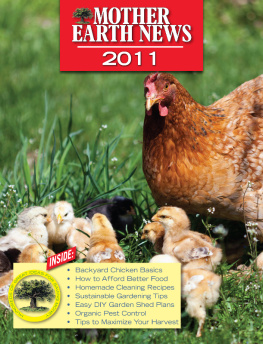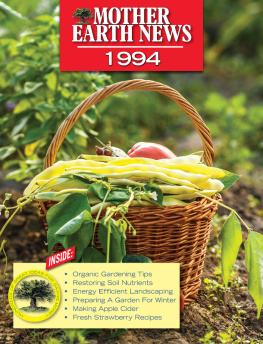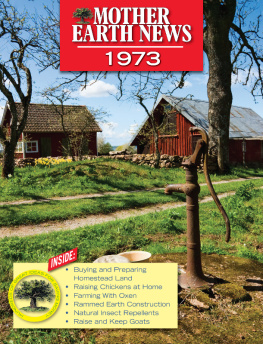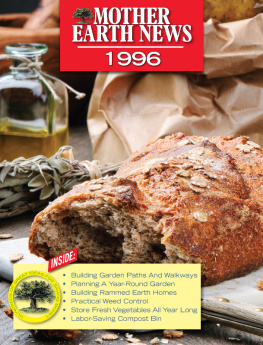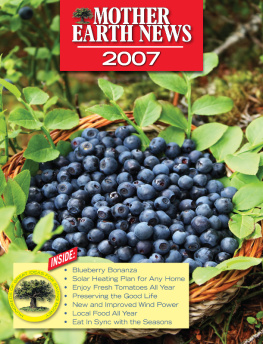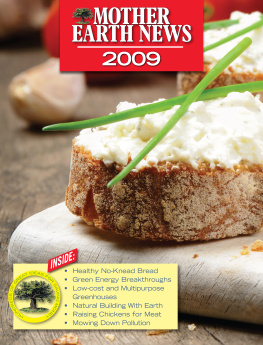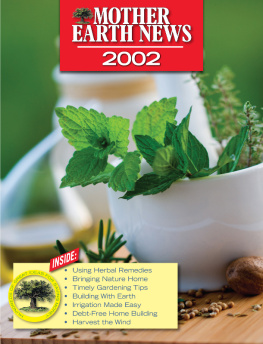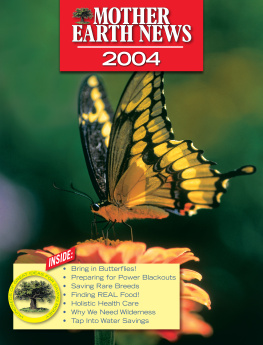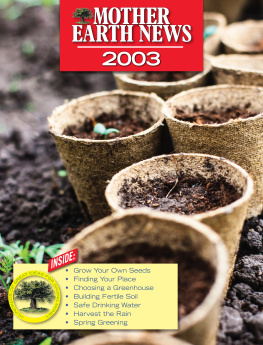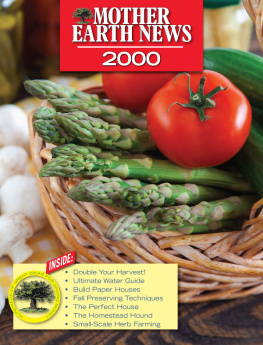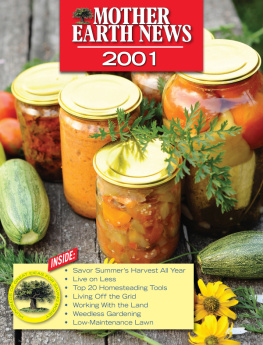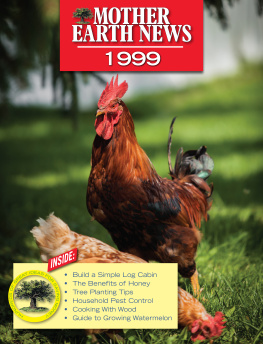Mother Earth News - Mother Earth News 1980
Here you can read online Mother Earth News - Mother Earth News 1980 full text of the book (entire story) in english for free. Download pdf and epub, get meaning, cover and reviews about this ebook. year: 1980, publisher: Mother Earth News, genre: Science / Home and family. Description of the work, (preface) as well as reviews are available. Best literature library LitArk.com created for fans of good reading and offers a wide selection of genres:
Romance novel
Science fiction
Adventure
Detective
Science
History
Home and family
Prose
Art
Politics
Computer
Non-fiction
Religion
Business
Children
Humor
Choose a favorite category and find really read worthwhile books. Enjoy immersion in the world of imagination, feel the emotions of the characters or learn something new for yourself, make an fascinating discovery.
- Book:Mother Earth News 1980
- Author:
- Publisher:Mother Earth News
- Genre:
- Year:1980
- Rating:5 / 5
- Favourites:Add to favourites
- Your mark:
- 100
- 1
- 2
- 3
- 4
- 5
Mother Earth News 1980: summary, description and annotation
We offer to read an annotation, description, summary or preface (depends on what the author of the book "Mother Earth News 1980" wrote himself). If you haven't found the necessary information about the book — write in the comments, we will try to find it.
Mother Earth News 1980 — read online for free the complete book (whole text) full work
Below is the text of the book, divided by pages. System saving the place of the last page read, allows you to conveniently read the book "Mother Earth News 1980" online for free, without having to search again every time where you left off. Put a bookmark, and you can go to the page where you finished reading at any time.
Font size:
Interval:
Bookmark:

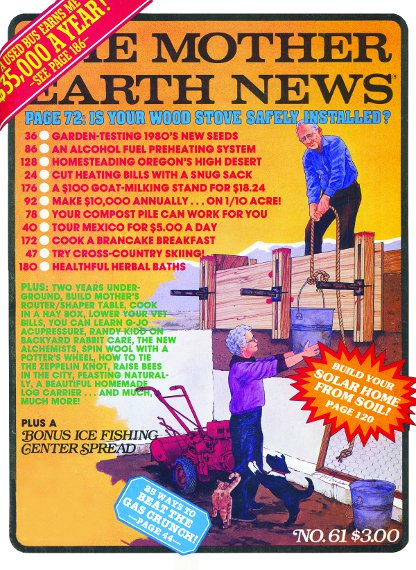
The staff of life doesnt to be expensive or complicated to be good. Simple Bread is highly nutritious, good tasting, inexpensive, and easy to prepare. Furthermore, one helping can provide 30 to 40 percent of your daily protein requirements (as well as hearty helpings of other nutrients) for about 18 - and cooking it demands an average of only 15 minutes of labor per day!
All you need to make a batch are 2 cups of whole wheat flour, 1/2 cup of soy flour, 1/4 cup of brewers yeast, 2/3 teaspoon of salt, and 1 1/3 cups of water. (As you can see, theres nothing fancy about Simple Bread!)
Before we start cooking, let me explain just why this basic manna is so nutritious. The total amount of complete protein in the recipes whole wheat and soy flours adds up to 28 grams. However - as you may already be aware - when whole wheat and soy are combined in four-to-one proportions, the result is a 32 percent increase in the amount of complete protein available. Therefore, a batch of Simple Bread actually contains 37 grams of the vital nutrient.
But thats not all. The 1/4 cup of brewers yeast adds another 8 grams (as well as some B vitamins), for a final total of 45 grams of protein. So, since the recipe yields a three-day supply of bread for one person - or a one-day cache for three eaters - a single batch can provide about 15 grams of complete protein per person per day. (The protein requirement for a 154-pound man is 43 grams daily, and that of a 128-pound woman is 36 grams per day.)
The cost of the ingredients (when purchased in one-pound units from a rather expensive health food store) breaks down as follows: 2 cups of whole wheat flour at 48 per pound is 24, 1/2 cup of soy flour at 56 per pound is 7, and 1/4 cup of brewers yeast at $3.85 per pound is 24 - which adds up to a total cost of about 55 for three days worth of bread!
(And, if you can buy the ingredients in bulk and grind the grain yourself, you can probably bring down the cost by as much as half.)
To begin making your batch of Simple Bread, combine the dry ingredients, add the water, and work the batter around until the moisture is absorbed. (A large wooden spoon is useful for this task.) Then put the ball of dough on a floured table and knead it for a few minutes until it becomes springy to the touch. Pull off a piece of dough a little larger than a golf ball and roll it out into a seven- to eight-inch tortilla. (You should wind up with about 12 such flatcakes when youre done.) And, as you finish rolling each piece, place it on a dry, hot griddle.
If your cooking surface is the right temperature, the dough will form small bubbles on its surface after about a minute. In approximately two minutes, the underside will be brown in spots, and the bread will be ready to be flipped. Then, when the other side is also brown (lift the edge to check), remove the finished bread with a spatula. (You can vary both the water content and cooking time to give your loaves the flexibility or crispness that best suits your taste.) Once you become adept at this cooking method, a three-day bread supply for one person (which should be stored in an airtight container) can be produced in about 45 minutes.
Its true that Simple Bread may take a little getting used to, but - after eating it for some time - I actually find it preferable to the conventional loaves. And dont let yourself get trapped into thinking that flatbread is good only with Mexican food. It can be consumed in almost every way that you eat conventional slices (with the possible exception of French toast).
And I always think - as I tear into this economical, highly nutritious, easy-to-prepare staff of life - that Simple Bread is simply marvelous!
PHOTO: MOTHER EARTH NEWS STAFF
Simple bread, deceptively easy-to-make, is also inexpensive and delicious to boot!
As you probably know, the human body functions as a pretty effective biological furnace ... and maintains a fairly constant 98.6F temperature. Trouble is, although it seems as if such a heating capability ought to be able to keep us warm under most any circumstances, were just not very well insulated by nature ... and so our body heat begins to dissipate as soon as it comes in contact with chilly air. When that happens, most folks resort to expensive-and perhaps soon to be in short supply- outside generators of heat.
But that doesnt have to be the case. You see, your lack of natural insulation can easily be compensated for with a snug sack ... a luxurious piece of apparel that will allow you to turn the ol thermostat down and stay comfortable-as you read, write, nap, or do craft work-while relying on your own built-in energy source!
Unfortunately, the cozy cuddlers have become such hot items that they often sell for upward of $30 in retail outlets! Theres no need to spend that kind of money, though, because if you have an old comforter or quilt around the house (even one thats a little worn around the edges will do), you can sew up your own portable environment snug sack or body sack in no more than a couple of hours. Furthermore, youll only have to invest a total of about $2.00 (for a heavy-duty zipper and some snaps), and the sewing skills required for the project are strictly at a beginners level!
Before you start cutting and sewing, youll want to measure-from the shoulders to the feet-the body of the person wholl be enjoying the finished sack. Remember to add a foot or so to the resulting measurement ... to allow extra room for sitting and stretching. (As a general rule, snug sacks are made from pieces of quilted material about 60 in width. The lengths of store-bought warmers are usually about 64 for a small sack, 78 for a medium snuggler, and 85 for a large one. However, since youre making your own, you have a choice of tailoring the material to produce a custom-sized bag or simply stitching up whatever quilt you have on hand as is ... to avoid cutting-and then having to hem-the material.)
Now lay the quilt or comforter flat on the floor... with the surface that will form the outside of the snug sack facing up. Fold the long edges in toward the middle until they meet. Next, using a sturdy thread, sew the center seam up-from the bottom-for a length of about 14 to 16 inches ... and then stitch the bottom seam closed.
With that done, turn the bag right side out... then start at the top of the stitched portion of the center seam and install a 26 to 34 heavy-duty zipper (the length of this closure will depend upon the size of your sack). Then place six snaps or buttonholes-three on each side and spaced approximately six inches apart-along the inside of the top front edges. Finally, affix a corresponding snap or button just inside the front edges of the bag ... one to each side of the top of the zipper. (The various small fasteners will allow you to fold the bags corners down and secure them in place to form adjustable sleeves.)
Font size:
Interval:
Bookmark:
Similar books «Mother Earth News 1980»
Look at similar books to Mother Earth News 1980. We have selected literature similar in name and meaning in the hope of providing readers with more options to find new, interesting, not yet read works.
Discussion, reviews of the book Mother Earth News 1980 and just readers' own opinions. Leave your comments, write what you think about the work, its meaning or the main characters. Specify what exactly you liked and what you didn't like, and why you think so.


